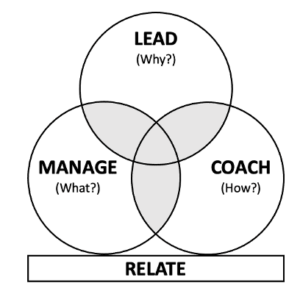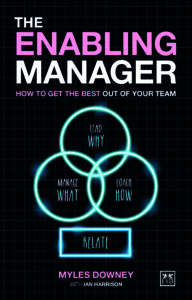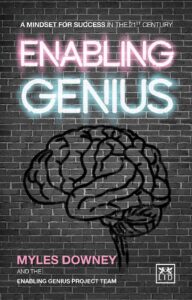|
The Enabling Leader Model – what is it and why you should be implementing it by Myles Downey & Ian Harrison
By Guest Contributors Myles Downey & Ian Harrison, Authors of The Enabling Manager
Most people don’t like being managed. One survey even suggested that the thing people dislike most at work was time spent with their manager. This shouldn’t surprise anyone. Gallup has long argued that the most significant factor in employee engagement is the behaviour of managers. There are also numerous studies that suggest that the manager is the primary cause of most people leaving their jobs.
There is a clear and pressing need for a change in the way managers go about the work of managing their teams.
The management culture in most larger organisations is still founded on a ‘Command-and-Control’ approach. This doesn’t work so well in the 21st Century because people are less compliant than their parents were and have a greater sense of their own autonomy – they are less respectful of position, authority and hierarchy. It also doesn’t work because Command-and-Control tends to create a climate of fear and suppression, and that kills performance.
What’s required is a culture and management approach that creates the conditions for high performance and innovation, where self-expression and learning are possible and where work is meaningful. A culture that’s appropriate for the people in work now. We call it Align-and-Enable.
Align-and-Enable includes three skills in which the team manager should be proficient: Lead, Manage, Coach. Lead is about the ‘Why’: the organisation’s purpose and goals and how the individual team member relates to them. Manage is about the ‘What’: the objectives and standards the team member works to. Coach is about the ‘How’: the team members approach to achieving their objectives.
When the Why, What and How are clear, most of the conditions for high performance are met. For the team member this translates as more meaning in their work and therefore more engagement. It increases the likelihood that they’ll be successful and, along the way, develop themselves and their skills. Work becomes more fulfilling. For the organisation it looks like more productivity, more innovation, and better decisions made faster. Greater effectiveness and efficiency across large numbers of people is a really meaningful goal for any organisation.
The practical core of Align-and-Enable is The Enabling Leader Model. This is a simple way of understanding your role which will support you in building the habits and practices of a successful team leader.
The Four Activities of an Enabling Leader
The Enabling Leader model identifies four inter-related activities:

Every great team is built on the foundation of good relationships and the first, essential activity of anyone seeking to align and enable their team is to build and maintain effective relationships.
In broad terms, the other three activities can be summarised as follows. To Lead is to provide context – to explain WHY the work is being done (Align). To Manage is to communicate the practicalities – to explain WHAT work needs to be done and WHAT the business requires in terms of processes and procedures (Align). Finally, to Coach is to work with your team to determine HOW the work will be done (Enable).
Here’s the extraordinary thing: when an individual team member knows WHY their work is important, has real clarity about WHAT needs doing and equally has clarity about HOW they are going to execute their tasks many of the conditions required for high performance are met.
When you focus on these four activities you will address many of the issues people have with their managers.
- Team members will be more engaged and purposeful
- Team members, knowing the context, will make better and quicker decisions
- Team members will have a clear focus and a mandate
- Team members will understand the scope of their work and any constraints
- Team members will have greater ownership of their role, goals decisions and actions
- Team members will learn and grow
A message that cannot be ignored
Needless to say, much of the business world has resisted the needed change: when you’ve tasted power it’s difficult to give it up!
When Millennials first began to enter the workforce, they were seen as being difficult to attract and even more difficult to retain; impossible to manage and a threat to prevailing business culture. The business press described them as demanding, disengaged with work, easily distracted and holding a naive sense of entitlement.
But look deeper and you will find that they want work that has meaning and purpose; empowerment to get on with the job; development and growth; a path to promotion; and the freedom to work where and when they want. Desires that became much more widely embraced during the pandemic of 2020/21. These changes are likely to stick, not simply because they would make life more pleasant, but because work itself would be both more productive and more fulfilling.
We are at an inflection point where the change in the curve can just be detected, and what comes next is slowly emerging.
Rather than presenting a problem, the much-maligned Millennials are pointing the way. Their desire for work that has meaning, growth and empowerment requires an approach to leadership that seeks to align-and-enable rather than command-and-control. The Enabling Leader Model provides a practical way for managers to think about their role that delivers results.
ABOUT THE AUTHORS
 Myles Downeyis a leading authority on performance, coaching and leadership, focused on ‘Enabling Genius.’ He is widely regarded as one of the foremost Leader Performance coaches in Europe. As an author, he has written three clas-sics: Effective Coaching, Effective Modern Coaching and Enabling Genius. His coaching books have together sold more than 300,000 copies. The founder of The School of Coaching, he has worked across the globe in most business sectors. He is partner with People Squared Ltd, where he helped create a unique mobile learning platform Boost Leadership, which facilitates behavioural change at scale. In 2017, he worked with the coaches of the England Rugby squad.
Myles Downeyis a leading authority on performance, coaching and leadership, focused on ‘Enabling Genius.’ He is widely regarded as one of the foremost Leader Performance coaches in Europe. As an author, he has written three clas-sics: Effective Coaching, Effective Modern Coaching and Enabling Genius. His coaching books have together sold more than 300,000 copies. The founder of The School of Coaching, he has worked across the globe in most business sectors. He is partner with People Squared Ltd, where he helped create a unique mobile learning platform Boost Leadership, which facilitates behavioural change at scale. In 2017, he worked with the coaches of the England Rugby squad.

Ian Harrison works with leaders and their teams around the UK, supporting them to create great places to work. He is the creator of Gratitude Mapping, a tool being used by teams to strengthen connections, break down silos and build positive cultures where people feel valued. Ian spent 19 years as the minister of churches in and around the West Midlands. He has sat on the board of charities and for two years was part of the volunteer team that delivered TEDxBrum. He lives in Wolverhampton but at the weekend you’ll find him at Elwood Park, watching Blackburn Rovers.
Suggested Reading

A practical, modern book for managers and leaders, at any level and in any department or company, who need to know how to get the best from their teams in a 21st Century business world. The world of work and the needs of people in the workplace have changed to the extent that the old models no longer work. Today’s manager cannot rely on “command-and-control” and a culture of compliance to get their job done.

This fascinating book examines the nature of genius in human beings and what it takes to go beyond mediocrity and ordinariness. Written by a leading thinker and consultant in human performance, together with contributions from other experts in the field, the book identifies three specific kinds of genius that are within everyone’s reach: unique individual genius (in a specific discipline, craft or skill set); genius in any discipline, craft or skill set; moments of genius (that occur as spontaneous, unplanned events); and collective genius (the coming together of individuals to deliver something extraordinary).
